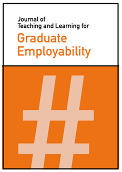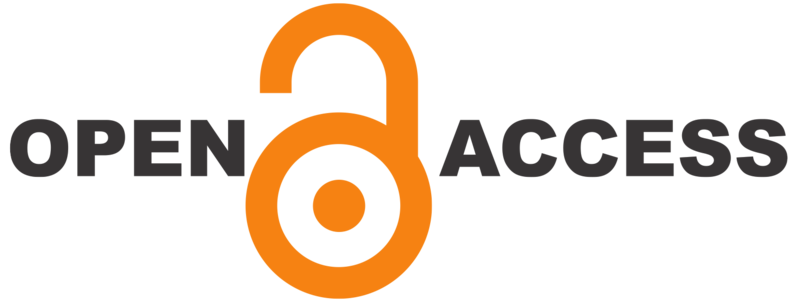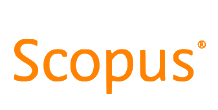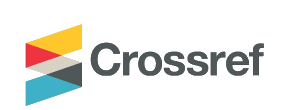A Process Model for Designing Employability Award Programs to Develop Graduate Employability
DOI:
https://doi.org/10.21153/jtlge2023vol14no1art1751Abstract
Employability awards have been implemented within universities as a strategy to support student development of employability and ultimately attainment of employment. The extant research into employability awards lacks a theoretical approach to designing and evaluating the impact of employability awards on relevant outcomes including employability and employment. This paper, informed by career construction theory, proposes a learner-focused, process model for developing employability. It also paves the way for future research to evaluate the impact of employability award programs.
Metrics
References
Al-Saedi, A., Bell, J., Boorman, A., Cameron, E., Castleman, Z., Flanagan, C., Fraser, C., Pearson, J., Philp, A., Robinson, K., Silva, F., Taki, A., Tubeileh, D., Vosters, R., & Mulrooney, H. M. (2019). Public health teaching in practice, peer learning and partnership working: The cook school project. New Directions in the Teaching of Physical Sciences, 12(1). https://eprints.kingston.ac.uk/id/eprint/44687/1/Mulrooney-H-44687-VoR.pdf
Barrie, S. C. (2006). Understanding what we mean by the generic attributes of graduates. Higher Education, 51, 215–241. https://doi.org/10.1007/s10734-004-6384-7
Bennett, D., Knight, E., Divan, A., Kuchel, L., Horn, J., van Reyk, D., & Burke da Silva, K. (2017). How do research-intensive universities portray employability strategies? A review of their websites. Australian Journal of Career Development, 26(2), 52–61. https://doi.org/10.1177/1038416217714475
Bridgstock, R. (2019). Graduate Employability 2.0: Learning for life and work in a socially networked world. In J. Higgs, G. Crisp, & W. Letts (Eds.), Education for Employability (Volume 1): The employability agenda. Brill. https://doi.org/10.1163/9789004400832_008
Bridgstock, R., & Jackson, D. (2019). Strategic institutional approaches to graduate employability: Navigating meanings, measurements and what really matters. Journal of Higher Education Policy and Management, 41(5), 468–484. https://doi.org/10.1080/1360080x.2019.1646378
Bridgstock, R., Jackson, D., Lloyd, K., & Tofa, M. (2019). Social connectedness and graduate employability: Exploring the professional networks of graduates from business and creative industries. In R. Bridgstock & N. Tippett (Eds.), Higher education and the future of graduate employability. Edward Elgar Publishing. https://doi.org/10.4337/9781788972611.00012
Brown, J. L., Dollinger, M., Hammer, S., & McIlveen, P. (2021). Career adaptability and career adaptive behaviors: A qualitative analysis of university students’ participation in extracurricular activities. Australian Journal of Career Development, 30(3), 189–198. https://journals.sagepub.com/doi/abs/10.1177/10384162211067014
Brown, J. L., Hammer, S., Perera, H. N., & McIlveen, P. (2022). Relations between graduates’ learning experiences and employment outcomes: A cautionary note for institutional performance indicators. International Journal for Educational and Vocational Guidance, 22, 137–156. https://doi.org/10.1007/s10775-021-09477-0
Brown, J. L., Healy, M., Lexis, L., & Julien, B. (2019). Connectedness learning in the life sciences: LinkedIn as an assessment task for employability and career exploration. In R. Bridgstock & N. Tippett, Higher Education and the Future of Graduate Employability (pp. 100–119). Edward Elgar Publishing. https://doi.org/10.4337/9781788972611.00015
Brown, J. L., Healy, M., McCredie, T., & McIlveen, P. (2019). Career services in Australian higher education: Aligning the training of practitioners to contemporary practice. Journal of Higher Education Policy and Management, 41(5), 518–533. https://doi.org/10.1080/1360080x.2019.1646380
Brown, S. D., Ryan Krane, N. E., Brecheisen, J., Castelino, P., Budisin, I., Miller, M., & Edens, L. (2003). Critical ingredients of career choice interventions: More analyses and new hypotheses. Journal of Vocational Behavior, 62(3), 411–428. https://doi.org/10.1016/S0001-8791(02)00052-0
Buyukgoze-Kavas, A. (2016). Predicting career adaptability from positive psychological traits. The Career Development Quarterly, 64(2), 114–125. https://doi.org/10.1002/cdq.12045
Chilvers, L., & Waghorne, J. (2018). Exploring PASS leadership beyond graduation. Journal of Peer Learning, 11, 5–26. http://ro.uow.edu.au/ajpl/vol11/iss1/2
Clark, G., Marsden, R., Whyatt, J. D., Thompson, L., & Walker, M. (2015). ‘It’s everything else you do…’: Alumni views on extracurricular activities and employability. Active Learning in Higher Education, 16(2), 133–147. https://doi.org/10.1177/1469787415574050
De Vos, A., Forrier, A., Van der Heijden, B., & De Cuyper, N. (2017). Keep the expert! Occupational expertise, perceived employability and job search. Career Development International, 22(3), 318–332. https://doi.org/10.1108/cdi-12-2016-0229
Dean, B. A., Ryan, S., Glover-Chambers, T., West, C., Eady, M. J., Yanamandram, V., Moroney, T., & O’Donnell, N. (2022). Career development learning in the curriculum: What is an academic’s role? Journal of Teaching and Learning for Graduate Employability, 13(1), 142–154. https://doi.org/10.21153/jtlge2022vol13no1art1539
Fernandez-Valera, M. M., Meseguer de Pedro, M., De Cuyper, N., Garcia-Izquierdo, M., & Soler Sanchez, M. I. (2020). Explaining job search behavior in unemployed youngsters beyond perceived employability: The role of psychological capital. Frontiers in Psychology, 11. https://doi.org/10.3389/fpsyg.2020.01698
Forrier, A., Verbruggen, M., & De Cuyper, N. (2015). Integrating different notions of employability in a dynamic chain: The relationship between job transitions, movement capital and perceived employability. Journal of Vocational Behavior, 89, 56–64. https://doi.org/10.1016/j.jvb.2015.04.007
Fugate, M. (2006). Employability in the new millennium. In J. H. Greenhaus & G. A. Callanan (Eds.), Encyclopedia of Career Development (Vol. 1, pp. 267–270). Sage.
Fugate, M., & Kinicki, A. J. (2008). A dispositional approach to employability: Development of a measure and test of implications for employee reactions to organizational change. Journal of Occupational and Organizational Psychology, 81(3), 503–527. https://doi.org/10.1348/096317907x241579
Fugate, M., Kinicki, A. J., & Ashforth, B. E. (2004). Employability: A psycho-social construct, its dimensions, and applications. Journal of Vocational Behavior, 65(1), 14–38. https://doi.org/10.1016/j.jvb.2003.10.005
Greenbank, P. (2015). Still focusing on the “essential 2:1”: Exploring student attitudes to extra-curricular activities. Education + Training, 57(2), 184–203. https://doi.org/10.1108/et-06-2013-0087
Griffin, P., Coates, H., McInnis, C., & James, R. (2003). The development of an extended course experience questionnaire. Quality in Higher Education, 9(3), 259–266. https://doi.org/10.1080/135383203200015111
Guan, Y., Guo, Y., Bond, M. H., Cai, Z., Zhou, X., Xu, J., Zhu, F., Wang, Z., Fu, R., Liu, S., Wang, Y., Hu, T., & Ye, L. (2014). New job market entrants’ future work self, career adaptability and job search outcomes: Examining mediating and moderating models. Journal of Vocational Behavior, 85(1), 136–145. https://doi.org/10.1016/j.jvb.2014.05.003
Hammer, S., Ayriss, P., & McCubbin, A. (2021). Style or substance: How Australian universities contextualise their graduate attributes for the curriculum quality space. Higher Education Research & Development, 40(3), 508–523. https://doi.org/10.1080/07294360.2020.1761304
Healy, M., Hammer, S., & McIlveen, P. (2022). Mapping graduate employability and career development in higher education research: A citation network analysis. Studies in Higher Education, 47(4), 799–811. https://doi.org/10.1080/03075079.2020.1804851
Hirschi, A., Herrmann, A., & Keller, A. C. (2015). Career adaptivity, adaptability, and adapting: A conceptual and empirical investigation. Journal of Vocational Behavior, 87, 1–10. https://doi.org/10.1016/j.jvb.2014.11.008
Inceoglu, I., Selenko, E., McDowall, A., & Schlachter, S. (2019). (How) Do work placements work? Scrutinizing the quantitative evidence for a theory-driven future research agenda. Journal of Vocational Behavior, 110, 317–337. https://doi.org/10.1016/j.jvb.2018.09.002
Jackson, D. (2015). Employability skill development in work-integrated learning: Barriers and best practice. Studies in Higher Education, 40(2), 350–367. https://doi.org/10.1080/03075079.2013.842221
Jackson, D., & Bridgstock, R. (2021). What actually works to enhance graduate employability? The relative value of curricular, co-curricular, and extra-curricular learning and paid work. Higher Education, 81(4), 723–739. https://doi.org/10.1007/s10734-020-00570-x
Jackson, D., & Tomlinson, M. (2021). The relative importance of work experience, extra-curricular and university-based activities on student employability. Higher Education Research & Development, 41(4), 1119–1135. https://doi.org/10.1080/07294360.2021.1901663
Jiang, Z. (2017). Proactive personality and career adaptability: The role of thriving at work. Journal of Vocational Behavior, 98, 85–97. https://doi.org/10.1016/j.jvb.2016.10.003
Johnston, C. S. (2018). A systematic review of the career adaptability literature and future outlook. Journal of Career Assessment, 26(1), 3–30. https://doi.org/10.1177/1069072716679921
Jorre de St Jorre, T., Elliott, J., Johnson, E. D., & Bisset, S. (2019). Science students’ conceptions of factors that will differentiate them in the graduate employment market. Journal of Teaching and Learning for Graduate Employability, 10(1), 27–41. https://doi.org/10.21153/jtlge2019vol10no1art795
Kinash, S., Crane, L., Judd, M. M., & Knight, C. (2016). Discrepant stakeholder perspectives on graduate employability strategies. Higher Education Research & Development, 35(5), 951–967. https://doi.org/10.1080/07294360.2016.1139555
Lent, R. W., Ireland, G. W., Penn, L. T., Morris, T. R., & Sappington, R. (2017). Sources of self-efficacy and outcome expectations for career exploration and decision-making: A test of the social cognitive model of career self-management. Journal of Vocational Behavior, 99, 107–117. https://doi.org/10.1016/j.jvb.2017.01.002
Lin-Stephens, S., Kubicki, J. M., Jones, F., Whiting, M. J., Uesi, J., & Bulbert, M. W. (2019). Building student employability through interdisciplinary collaboration: An Australian case study. College & Undergraduate Libraries, 26(3), 234–251. https://doi.org/10.1080/10691316.2019.1674027
Littman-Ovadia, H., Lazar-Butbul, V., & Benjamin, B. A. (2014). Strengths-based career counseling: Overview and initial evaluation. Journal of Career Assessment, 22(3), 403–419. https://doi.org/10.1177/1069072713498483
Liu, S., Huang, J. L., & Wang, M. (2014). Effectiveness of job search interventions: A meta-analytic review. Psychological Bulletin, 140(4), 1009–1041. https://doi.org/10.1037/a0035923
McIlveen, P., Brooks, S., Lichtenberg, A., Smith, M., Torjul, P., & Tyler, J. (2011). Career development learning frameworks for work-integrated learning. In S. Billett & A. Henderson (Eds.), Developing learning professionals: Integrating experiences in university and practice settings (pp. 149–165). Springer. https://doi.org/10.1007/978-90-481-3937-8_9
Oliver, B., & Jorre de St Jorre, T. (2018). Graduate attributes for 2020 and beyond: Recommendations for Australian higher education providers. Higher Education Research & Development, 37(4), 821–836. https://doi.org/10.1080/07294360.2018.1446415
Open-Source Psychometrics Project. (2019). Big five personality test. https://openpsychometrics.org/tests/IPIP-BFFM/
Pajic, S., Ulceluse, M., Kismihok, G., Mol, S. T., & den Hartog, D. N. (2018). Antecedents of job search self-efficacy of Syrian refugees in Greece and the Netherlands. Journal of Vocational Behavior, 105, 159–172. https://doi.org/10.1016/j.jvb.2017.11.001
Perera, H. N., & McIlveen, P. (2017). Profiles of career adaptivity and their relations with adaptability, adapting, and adaptation. Journal of Vocational Behavior, 98, 70–84. https://doi.org/10.1016/j.jvb.2016.10.001
Praskova, A., Creed, P. A., & Hood, M. (2015). Career identity and the complex mediating relationships between career preparatory actions and career progress markers. Journal of Vocational Behavior, 87, 145–153. https://doi.org/10.1016/j.jvb.2015.01.001
Pryor, R., & Bright, J. (2011). The chaos theory of careers: A new perspective on working in the twenty-first century. Routledge.
Rothwell, A., & Arnold, J. (2007). Self‐perceived employability: Development and validation of a scale. Personnel Review, 36(1), 23–41. https://doi.org/10.1108/00483480710716704
Rothwell, A., Herbert, I., & Rothwell, F. (2008). Self-perceived employability: Construction and initial validation of a scale for university students. Journal of Vocational Behavior, 73(1), 1–12. https://doi.org/10.1016/j.jvb.2007.12.001
Rottinghaus, P. J., Buelow, K. L., Matyja, A., & Schneider, M. R. (2012). The Career Futures Inventory-Revised: Measuring dimensions of career adaptability. Journal of Career Assessment, 20(2), 123–139. https://doi.org/10.1177/1069072711420849
Rottinghaus, P. J., Day, S. X., & Borgen, F. H. (2005). The Career Futures Inventory: A measure of career-related adaptability and optimism. Journal of Career Assessment, 13(1), 3–24. https://doi.org/10.1177/1069072704270271
Rottinghaus, P. J., & Eshelman, A. J. (2015). Integrative approaches to career intervention. In P. Hartung, M. L. Savickas, & W. B. Walsh (Eds.), APA handbook of career intervention. Volume 2: Applications. (pp. 25–39). American Psychological Association. https://doi.org/10.1037/14439-003
Rudolph, C. W., Lavigne, K. N., Katz, I. M., & Zacher, H. (2017). Linking dimensions of career adaptability to adaptation results: A meta-analysis. Journal of Vocational Behavior, 102, 151–173. https://doi.org/10.1016/j.jvb.2017.06.003
Rudolph, C. W., Lavigne, K. N., & Zacher, H. (2017). Career adaptability: A meta-analysis of relationships with measures of adaptivity, adapting responses, and adaptation results. Journal of Vocational Behavior, 98, 17–34. https://doi.org/10.1016/j.jvb.2016.09.002
Russell, L., & Kay, J. (2019). Building student employability from day one. In J. Higgs, G. Crisp, & W. Letts (Eds.), Education for Employabilty (Vol. 2, pp. 133–142). Brill.
Saks, A. M., Zikic, J., & Koen, J. (2015). Job search self-efficacy: Reconceptualizing the construct and its measurement. Journal of Vocational Behavior, 86, 104–114. https://doi.org/10.1016/j.jvb.2014.11.007
Salanova, M., & Ortega-Maldonado, A. (2019). Psychological capital development in organizations: An integrative review of evidence-based intervention programs. In L. E. Van Zyl & S. Rothmann Sr (Eds.), Positive psychological intervention design and protocols for multi-cultural contexts (pp. 81–102). Springer. https://doi.org/10.1007/978-3-030-20020-6_4
Santilli, S., Marcionetti, J., Rochat, S., Rossier, J., & Nota, L. (2017). Career adaptability, hope, optimism, and life satisfaction in Italian and Swiss Adolescents. Journal of Career Development, 44(1), 62–76. https://doi.org/10.1177/0894845316633793
Savickas, M. L. (2005). The theory and practice of career construction. In S. D. Brown & R. W. Lent (Eds.), Career development and counseling: Putting theory and research to work (pp. 42–70). John Wiley & Sons.
Savickas, M. L. (2013). Career construction theory and practice. In S. D. Brown & R. W. Lent (Eds.), Career development and counseling: Putting theory and research to work (2nd ed.). John Wiley & Sons.
Savickas, M. L., & Porfeli, E. J. (2012). Career Adapt-Abilities Scale: Construction, reliability, and measurement equivalence across 13 countries. Journal of Vocational Behavior, 80(3), 661–673. https://doi.org/10.1016/j.jvb.2012.01.011
Savickas, M. L., Porfeli, E. J., Hilton, T. L., & Savickas, S. (2018). The Student Career Construction Inventory. Journal of Vocational Behavior, 106, 138–152. https://doi.org/10.1016/j.jvb.2018.01.009
Social Research Centre. (2020). 2020 Graduate Outcomes Survey methodological report. https://www.qilt.edu.au/docs/default-source/default-document-library/2020-gos-methodological-report.pdf?sfvrsn=9a350998_3
Spurk, D., Kauffeld, S., Meinecke, A. L., & Ebner, K. (2016). Why do adaptable people feel less insecure? Indirect effects of career adaptability on job and career insecurity via two types of perceived marketability. Journal of Career Assessment, 24(2), 289–306. https://doi.org/10.1177/1069072715580415
Spurk, D., Volmer, J., Orth, M., & Göritz, A. S. (2020). How do career adaptability and proactive career behaviours interrelate over time? An inter- and intraindividual investigation. Journal of Occupational and Organizational Psychology, 93(1), 158–186. https://doi.org/10.1111/joop.12288
Strauss, K., Griffin, M. A., & Parker, S. K. (2012). Future work selves: How salient hoped-for identities motivate proactive career behaviors. Journal of Applied Psychology, 97(3), 580–598. https://doi.org/10.1037/a0026423
Tomasson Goodwin, J., Goh, J., Verkoeyen, S., & Lithgow, K. (2019). Can students be taught to articulate employability skills? Education + Training, 61(4), 445–460. https://doi.org/10.1108/ET-08-2018-0186
Tomlinson, M. (2017). Forms of graduate capital and their relationship to graduate employability. Education + Training, 59(4), 338–352. https://doi.org/10.1108/et-05-2016-0090
Tomlinson, M., McCafferty, H., Port, A., Maguire, N., Zabelski, A. E., Butnaru, A., Charles, M., & Kirby, S. (2021). Developing graduate employability for a challenging labour market: The validation of the graduate capital scale. Journal of Applied Research in Higher Education, 14(3), 1193-1209. https://doi.org/10.1108/jarhe-04-2021-0151
Watson, R. (2011). A rationale for the development of an extracurricular employability award at a British university. Research in Post-Compulsory Education, 16(3), 371–384. https://doi.org/10.1080/13596748.2011.602248
Watts, A. G. (2006). Career development learning and employability. Learning and Employability Series 2. The Higher Education Academy. http://www.qualityresearchinternational.com/esecttools/esectpubs/watts%20career.pdf
Wendling, E., & Sagas, M. (2022). Development and validation of the Career Identity Development Inventory. Journal of Career Assessment, 30(4), 678–696. https://doi.org/10.1177/10690727211063374
Whiston, S. C., Li, Y., Mitts, N. G., & Wright, L. (2017). Effectiveness of career choice interventions: A meta-analytic replication and extension. Journal of Vocational Behavior, 100, 175–184. https://doi.org/10.1016/j.jvb.2017.03.010
Yorke, M., & Knight, P. (2004). Embedding employability into the curriculum. Learning & Employability Series 1. The Higher Education Academy. http://www.employability.ed.ac.uk/documents/staff/heabriefings/esect-3-embedding_employability_into_curriculum.pdf
Downloads
Published
Issue
Section
License
Copyright (c) 2023 Jason L Brown

This work is licensed under a Creative Commons Attribution-NonCommercial 4.0 International License.












